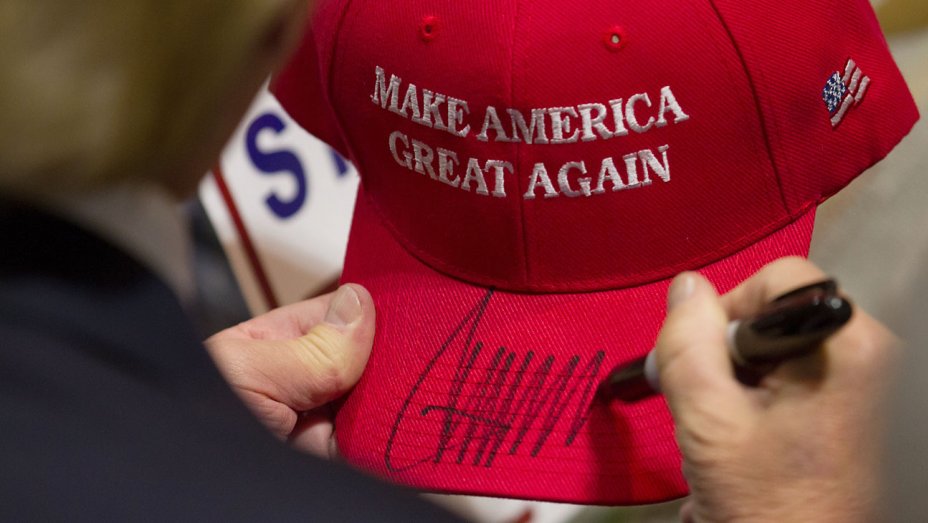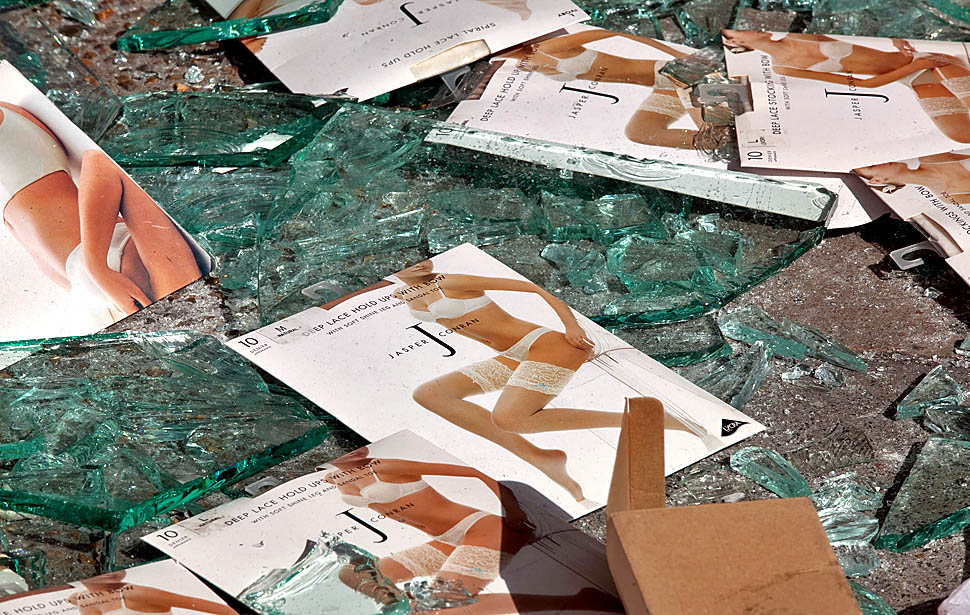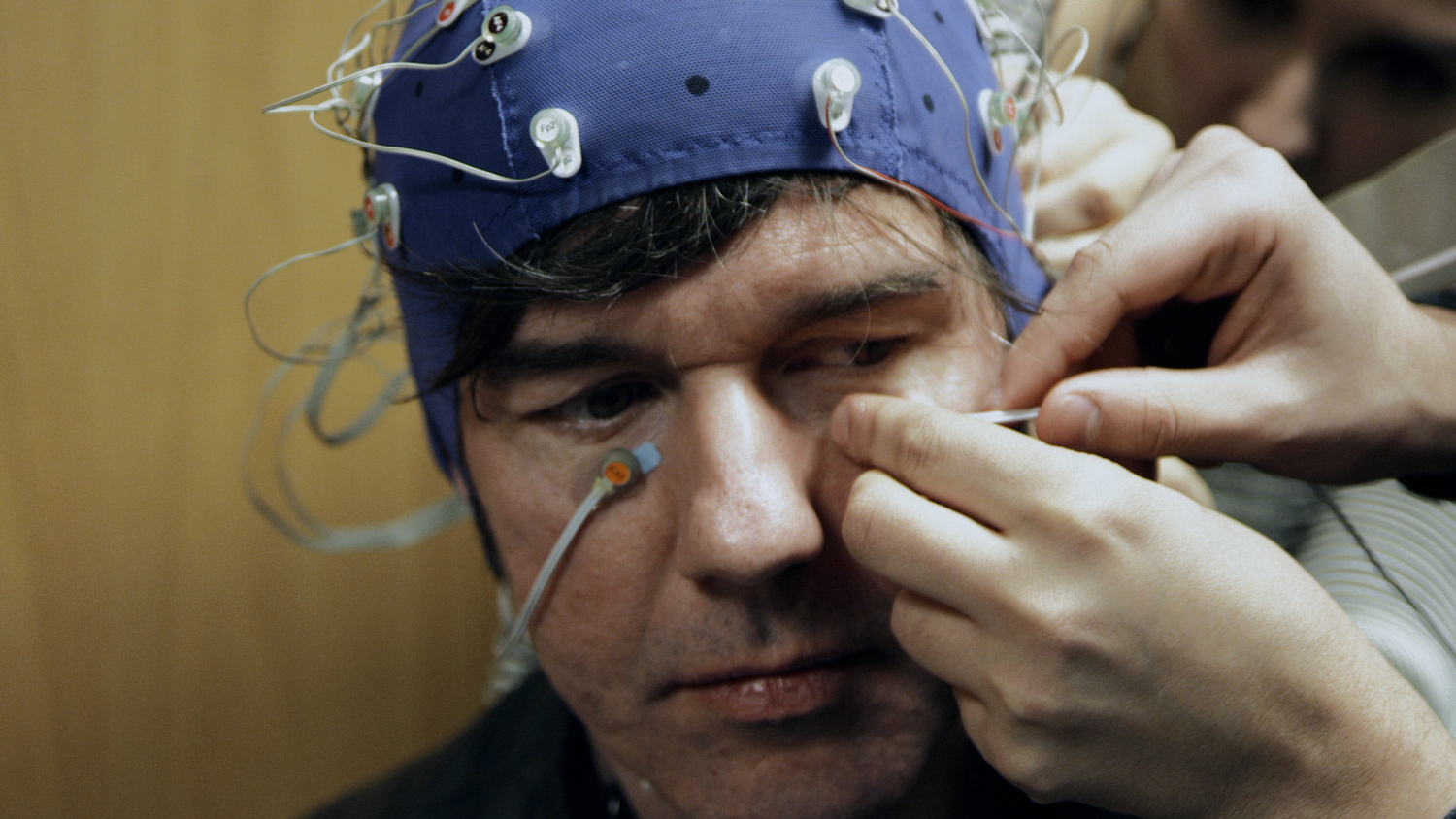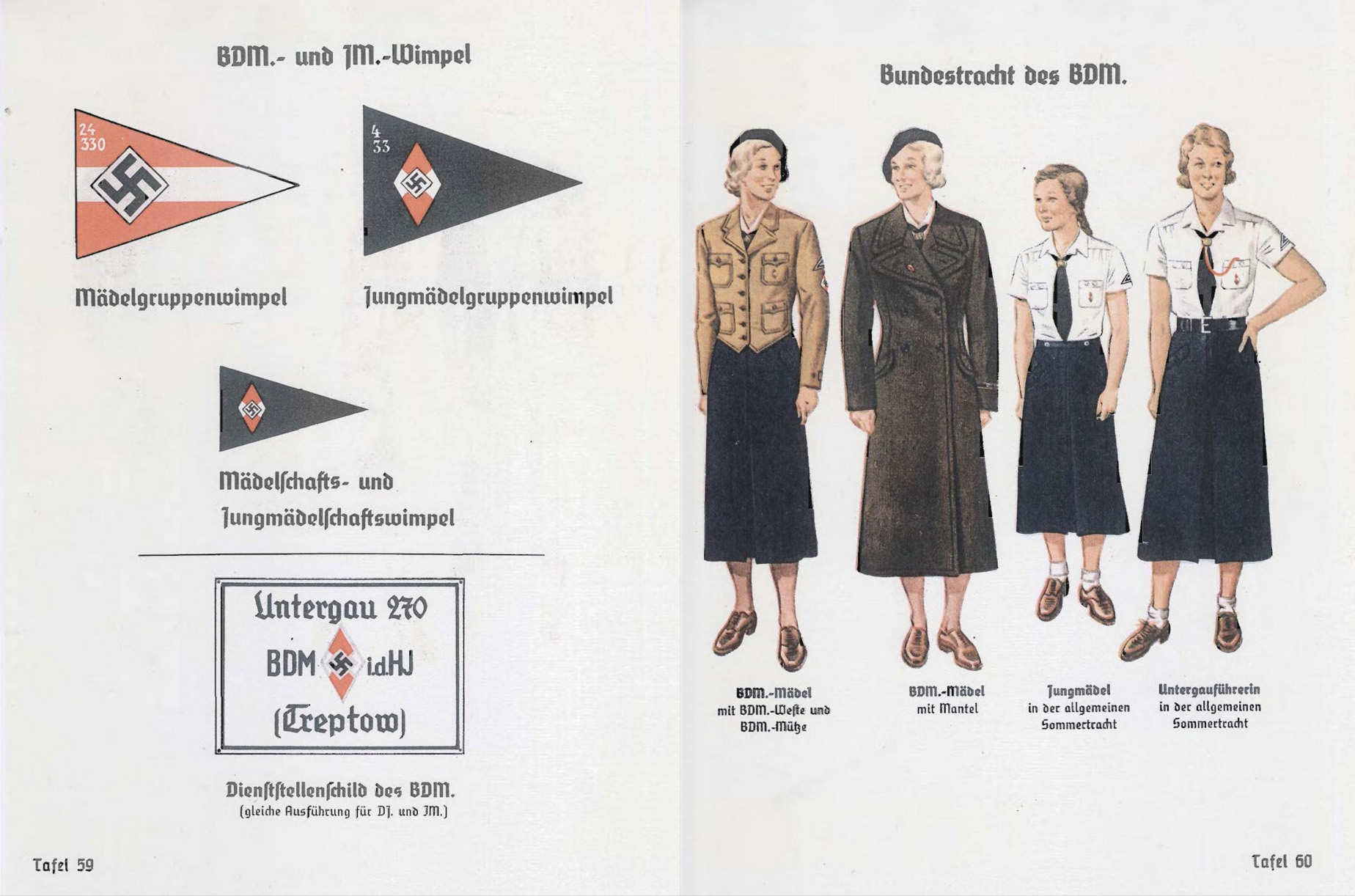In commercial design, anxiety, fear, and self-doubt are often summoned towards the distant promise of happiness. Any happiness then lasts only long enough to deepen the feelings of insecurity aroused to motivate consumption. And the whole spectacle, the vast, irreconcilable distance between desire and satisfaction, is micromanaged by designers.
But it is a particular kind of happiness. It is as fickle and fleeting as instant gratification, and as shallow as stale comfort. Authentic contentment is as elusive as proverbial quicksilver. Of course, real happiness doesn’t necessarily endure either, as William Burroughs wrote in his notes as he was dying: “People blather about ‘happiness,’ like some permanent medium you can accrete around yourself and never want for anything again. The archetypal swindler’s line.” Making America “great again” is making pissed-off (white) Americans happy again.

Donald Trump signing a hat. Photograph by Matthew Cavanaugh/Getty Images
And this is only half the story. The real story is invisible—it’s unseen because we are rewarded to look the other way: All this happiness is big trouble. The happiness created by corporate design doesn’t relieve the paralyzing tragedy and misery of the world; it just ignores or denies it. And this surface experience of the deep pain of others is itself an enabling condition of ideological affliction.
Economists have helped bring us to the brink. Unflinchingly, they watch as markets crumble, crash, and surge. Now they are also measuring happiness, and have actually calculated it would take roughly $60,000 (USD) to substitute for a friendship in equivalent happiness. Would you sell a treasured relationship for that sum? What would you buy with it? Half of a Porsche? A kitchen renovation?
Jean Baudrillard’s idea that rich collectors demonstrate how “everything that cannot be invested in human relationships is invested in objects” can now be extended to us all, to every consumer—from respectable middle class families to rioting London teenagers.

Lingerie designed by Jasper Conrad on the floor of a looted department store during the 2011 London riots. Photograph by Simon Dawson/Bloomberg.
Governments can index happiness, economists can measure it, designers can design it, and the market can exploit it. But where is happiness on a dead planet?
There’s an increasingly discredited belief that our happiness grows as our economies balloon. This idea of progress and evolution, actual or imagined, is mirrored in many aspects of our culture. For example, typographers are interested in how the stages of children learning to read are mirrored in the human history of sign making—a process that began with simple, literal images on cave walls, followed by hieroglyphics, which in turn became letters with a phonetic alphabet to represent sounds rather than visual images. It’s also interesting that when we hope to communicate with extraterrestrial life forms, we revert to the earliest stages of this sign-making development. The Pioneer 10 spacecraft, for example, launched in 1972 with a plaque showing simple diagrammatic illustrations designed to explain ourselves to aliens. Human contact with other planets is becoming less fantastic as our post-truth politics forewarns a post-earth future.
One of happiness’ most common causes, the most profound and transformative human emotion, is, of course, love. This is the stuff that design covets. Brands now don’t just want our loyalty; they also want our love.
Our brain changes when we’re in love. The dose of dopamine that allows for the pleasurable associations experienced when we’re falling in love can rewire our brain. We can replace old habits with new tastes and preferences that influence how we feel about and act in the world. Does this sound like branding’s dream?
Long before graphic design attained the finely tuned sophistication of contemporary commercial image culture, John Berger wrote that publicity steals the self-love of an audience and offers it back for a price. If our positive emotional associations can be hijacked by brands, our affections can be transferred in a physical feat of brain chemistry. Ecstasies can be evoked as surges of dopamine lower our tolerance for pleasure and forge new affections for any commodity. And once the dopamine’s got us going, oxytocin lowers our guard and induces trust and attachment.
Or, in the words of one advertising luminary perhaps with a flair for neuroplasticity: “Lovemarks reach your heart as well as your mind, creating an intimate, emotional connection that you just can’t live without. Ever. [...] Lovemarks are a relationship, not a mere transaction. You don’t just buy Lovemarks, you embrace them passionately. That’s why you never want to let go. Put simply, Lovemarks inspire: Loyalty Beyond Reason.”
According to the Satchi & Satchi website, Lovemarks was named one of the 10 best “Ideas of the Decade” by Advertising Age magazine. It shared this honor with other noble ideas such as “brand journalism,” “marketer as media,” and what must be the advertising idea of any and all decades: “consumer control” (this phrase means the same thing however you interpret it).
Graphic designers are suddenly issuing much advice about happiness. Vince Frost has published a book called Design Your Life. Stefan Sagmeister's book is called Things I Have Learnd in my Life So Far, his TED talk 7 Rules for Making More Happiness and his documentary The Happy Film. James Victore’s weekly YouTube series, Burning Questions, “teaches creatives how to illuminate their individual gifts in order to achieve personal greatness.” Bruce Mau’s Incomplete Manifesto for Growth begins: “Allow events to change you. You have to be willing to grow…” Mau was thinking big for design, but it’s hard to swallow this barrage of belief in capitalism’s technological innovations towards a merely more finely tuned status quo. Tying the bombastic phrase “Massive Change,” for example, to such stunted aspirations, is a maneuver only possible under the happy spell of design. In such a state of excited contentment, all the market’s mechanisms of exploitation and inequality dissolve, and the politics of denial do their dirty work.

Stefan Sagmeister undergoing an EEG test in a scene from The Happy Film.
Guy Debord, who Mau cites in his book Life Style, wrote: “Young people everywhere have been allowed to choose between love and a garbage disposal unit. Everywhere they have chosen the garbage disposal unit.” To choose love, as easy as it sounds, would be massive change, but Mau offers us efficiency enhancements and technology instead. The project’s striving towards “the welfare of humanity” soon becomes “nothing but the vicissitudes of profitability,” as Baudrillard put it.
But as frustrated as our happiness is by design’s detours, there’s always plenty to be glad about. As Michel Foucault said, “Do not think that one has to be sad in order to be militant, even though the thing one is fighting is abominable.”
Or abominable and confusing. So many of the arguments for the promotion of our happiness and in defense of branding are interchangeable for indictments against it. “Brands are now writing the next chapters of our human journey. The transparency provided by technology does not remove the value of well-crafted stories, and never will. In fact, the more people interact, question and challenge brands’ narratives, the more engaged they will be. Beyond telling stories, brands are now allowing every one of us to be the story. Evolve in the dawning of a brand new world or become the prey.” These are the words of Sérgio Brodsky, an “internationally experienced brand marketing professional,” attempting to counter an article in the New Yorker titled “Twilight of the Brands.”
From Vance Packard’s The Hidden Persuaders to Naomi Klein’s No Logo and Lucas Conley’s recent Obsessive Branding Disorder, there have been popular attempts to raise the alarm. There is a dawning realization that contrary to the Brandologists’ claims, research and innovation is being distracted by the substantial resources invested in branding, that promised improvements in products and services are deferred while their promotions get sleeker and slipperier, and we’re left empty handed, or with fistfuls of junk.

Pages from the Organisationsbuch der NSDAP, 1937.
These foggy promises have a murky history. The late 19th century saw the rise of companies like Coca Cola and AEG with their advertising and design-led global aspirations. But branding is as much a totalitarian as a totalizing ideology, with its authoritarian intolerance of any values existing beyond its grasp and its way of “transcending all diversity,” as Carl Schmitt promoted Nazism. We need to heed George Orwell’s advice that “the word ‘Fascism’ is almost entirely meaningless ... almost any English person would accept ‘bully’ as a synonym for ‘Fascist.’” Still, it’s worth remembering that the bullying propaganda of branding could have begun with Hitler’s National Socialists. The Swastika and its omnipresent applications in 1930’s Germany saw the historical genesis of fully realized systematically programmed, contemporary branding methodology. The recent surge in interest about historical style guides somehow ignores the field’s foundational document: the Organisationsbuch der NSDAP (Organizational Handbook of the National Socialist Party), a branding blueprint covering every aspect of Nazi public communication.
As for graphic designers, we can part with much misery by breaking our ideological indenture, by rejecting branding’s totalitarian rhetoric. And we can side with happiness by responding to the real needs of the environment, communities, and individuals, rather than the priorities of privilege. Design can enable, rather than counterfeit and exploit human relationships. Designers can promote connection, not just consumption, so that the possibilities of happiness are not stylishly and systematically assaulted in the endless mire of mass representation.
Ultimately, what does anyone really know about finding happiness, except maybe that searching for it is futile? It is useless because the one thing we do know is that real happiness poises on a paradox contradicted by design’s devotion to consumer capitalism: happiness is intrinsic, not extrinsic, to us and yet we depend on each other in order to be human. Life is, as the Buddhist saying goes, ten thousand joys and ten thousand sorrows, and $60,000 or half of a Porsche won’t budge this balance one bit, no matter what the self-help entrepreneurs, brand gurus, and advertising mad men are selling. Our ideas and expectations of happiness can, and should, expand to include each other and all that sustains us.
Read more: Against Branding: Part 1 — Design and Conflict.
Based on talks given at the Asia Pacific Design Library’s lecture series.

